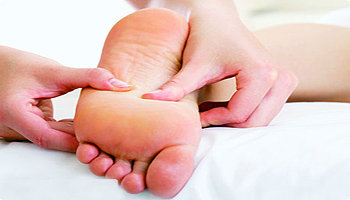| Home > China Feature |
Seeking a Balance
Foot reflexology, or foot massage, has become a popular way to relax and fight stress. It has been reported that even Princess Diana and Prince Charles had their feet massaged once a week. Find out what is making this ancient old therapy so hot.
According to Newsweek magazine, in the article "The Queen of Style" in the edition commemorating the life of Diana, wrote: "In the end, Diana looked less like a royal and more like a sleek Manhattan socialite. For one thing, she was well groomed. She got manicures and pedicures, had foot reflexology three times a week."

What is it?
Reflexology is based on the ancient massage technique that applies pressure on parts of the feet, or sometimes the hands and ears, to affect other parts of the body and/or improve general health. Practitioners of foot reflexology believe the foot is connected to all major organs and glands in the body. As such, they believe, working the foot is like working and healing the body. More specifically, each pressure point in the foot "mirrors" the health of a specific organ or part of the body. So when customers feel more tenderness than usual at a pressure point like the top of the toe, practitioners usually suggest that one's eyes are more tired than usual. The practitioner may suggest some healthy habits to lessen the stress in the eyes, such as looking far away (perhaps counting the leaves on a tree outside the window) for a few minutes for every hour spent on the computer or reading.
Although foot reflexology can help reduce stress and relieve various stress-related ailments, such as sleep disorders, back pain, digestive disorders, and arthritis, it should be used as a complement to, not a replacement for, modern medicine.
Reflexology dates back to 2500 BC. It was widely used by Egyptians and Chinese. Even some tribes in Africa worked with the points on the foot. Reflexology was introduced to the West as "zone therapy" by Dr William Fitzgerald in 1913. A couple of decades later, it was formulated and enhanced by Eunice Ingham (1889-1974), a physical therapist by occupation, she was a colleague of Fitzgerald who actively developed zone therapy. Zone therapy, unlike reflexology, does not connect the zones with the body as a whole. After Ingham discovered a pattern of reflexes on the human foot in 1930's, she devoted the rest of her life to publicizing the benefits of foot reflexology.
The Benefits
The main benefit of reflexology is the reduction of stress. Since the feet and hands help set the tension level for the body, massaging the areas can interrupt the stress signal and reset homeostasis, or the body's equilibrium.
When and Where?
Reflexology can be performed practically anytime and anywhere. However, the best results are derived when it is performed on a consistent basis.
Between sessions with your reflexologist, you should build reflexology into your daily routine; for example, put a foot roller under your desk or work your hands while you wait in line. Performing reflexology for a few minutes every day is better than having a one-hour session with a reflexologist every so often.
What to expect?
Reflexology sessions generally last between 30 minutes and one hour. Although you remove just your shoes and socks, you would be advised to wear comfortable clothes, especially loose-fitting pants, as your reflexologist will probably massage your legs at the end of your session.
The reflexologist will use a chair and, sometimes, oil and/or lotion to make it easier for him/her to apply pressure. Stretching, movement and the application of pressure are usually used to work through the foot. Traditionally, both feet are covered so they will not "catch a cold" during the session.
Seeking a Balance
Generally in China, women will request male reflexologists while males will ask for female reflexologists. That is because they believe there should be a balance between the ying and the yang, or the feminine and masculine energies, and that too much of either energy could result in an imbalance rather than the feeling of maximum relaxation after the session.
Remember to drink lots of water during and after your session. Why? The session will usually leave the body in "detox mode," and drinking water will help the "flushing" process. Although you can have a foot massage at any time of the day, many people prefer to have one at the end of the day to help them unwind and relax. It is not surprising to see someone fall asleep during their session.
Feel free to tell your reflexologist if he/she is applying too much pressure; however, a little tenderness is normal, especially if you are having your first session.
Traditionally, reflexologists do not recommend women to have a foot massage during their menstrual period, as they believe massaging the foot at that time will "daluan," or "mix up" the menstrual period.
You should feel relaxed, light footed and even a little hungry at the end of your session. The length of time you feel relaxed will be a good indicator of how effective your session was. Most of all, enjoy your session!
Art
 more
moreChina Beijing International Diet ...
Recently, The hit CCTV documentary, A Bite of China, shown at 10:40 ...

Exhibition of Ancient Chinese Jad...
At least 8,000 years ago, Chinese ancestors discovered a beautiful...

Longmen Grottoes
The Longmen Grottoes, located near Luoyang, Henan Province, are a tr...

Custom
 more
moreWeb Dictionary
Martial Arts
Tai Chi Master Class Held in Moscow
MOSCOW, June 15, 2016 (Xinhua) -- Students learn from Shaolin ...
Celebriting 70 years' efforts in restoring Mogao...
Work is being carried out at the restoration site of cave No 98 a...
Hong Kong Children's Symphony performs in Seattle
Under the theme of Tribute to the Golden Age, a concert featuring a ...





 print
print  email
email  Favorite
Favorite  Transtlate
Transtlate 








